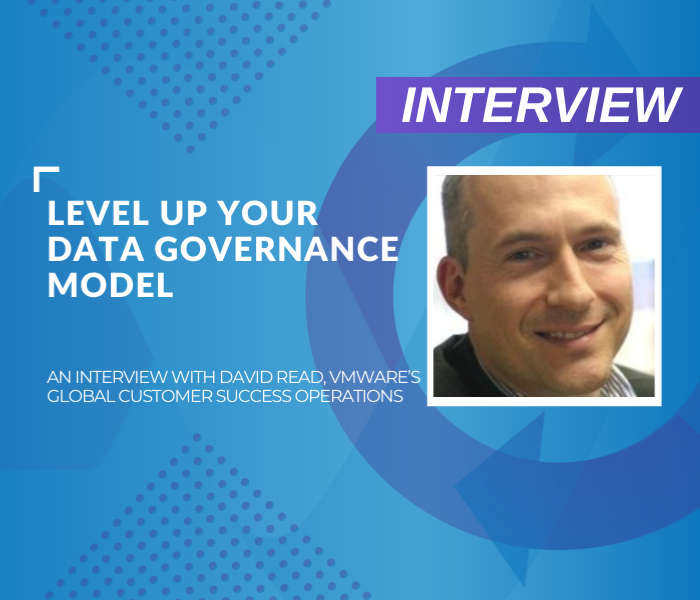Optimize Your Customer Data Model For The Modern Subscription Economy
Customer data is an integral and indispensable part of leveling up your customer lifecycle. While this statement isn’t groundbreaking or surprising, improving your organization’s data governance model can be very challenging when contending with large organizational silos and out-of-date legacy practices. These issues quickly result in an ineffective data model that confuses and burdens your teams, forcing them to compromise their customer engagements by taking action on inaccurate or incomplete insights. To rise above these obstacles, one of the most powerful approaches is to learn from the successes of like-minded organizations.
To uncover how leading enterprises are optimizing their data governance model for maximum value delivery, Valuize’s Founder & CEO, Ross Fulton, spoke with data expert David Read, Global Customer Success Operations at VMWare. Through his tenure at several industry-leading technology companies, David has transformed numerous Customer Success (CS) functions through a data-driven approach to customer health scoring, renewals and expansion. In this interview, David delves into the what, why and how of bad customer data and shares impactful advice to help you upgrade your approach to customer data management and analysis.
Q: Many technology enterprises suffer from “bad” customer data. From your experience, how do you define “bad” customer data?
A: “Bad customer data consists of several elements.
The first issue that many organizations run into is an ill defined customer hierarchy. What’s the structure of your customer hierarchy? What are the levels within it? How do you break that down across the geographical areas that you serve? How do you break them down across departments within your company? Defining your customer hierarchy across your organization and geographic locations is fundamental to building a strong data governance model.
The second piece is customer IDs. How do you define a customer across your organization? What you often see in enterprise organizations is cross-functional departments designing their systems independently, creating their own set of rules and governing practices, which inevitably leads to multiple ways of identifying a customer. While this is understandable given the unique use cases across your organization, what you end up with is vastly differing customer IDs that make it difficult to link the same customer across your various systems.
Related to the problem of customer IDs is customer contacts. Contacts are massively complex and difficult to keep consistent. When it comes to contact data, you want to ensure that John Smith is always John Smith. You don’t want to end up with 20 different John Smiths that are all actually the same person. Trying to manage that is surprisingly complicated, especially when you consider the vast network of systems that exists in today’s enterprises.
When you combine all of these pervasive issues together, it results in a tremendous amount of complexity and makes it incredibly difficult to get a single comprehensive view of the customer. Consequently, not being able to get that 360 degree view of the customer makes it challenging for your cross-functional teams to act in unison to create a seamless experience across your customer journey.”
Q: Why and how do companies get into the predicament of bad customer data?
A: “When it comes to bad customer data, the larger and the older the company, the larger the issue. In both cases, bad data practices have more time and opportunities to emerge and grow. At the same time, there is a root cause that stems from the silos that exist within an organization. Your cross-functional teams all have different use cases and they all build their systems and processes around these unique use cases. For example, your Financial team’s use cases, focused on obtaining a financial view of the customer, are entirely different to your Sales and Marketing and your Customer Success and Support use cases and personas. As you can imagine, this leads to a deepening of silos and bad customer data. Ultimately, you end up with three different sets of systems that don’t communicate with one other, exacerbating the problem of bad data governance models.”
Q: The transition from the legacy license-based to subscription-based model has completely changed the way we engage with customers and measure customer value. What are your thoughts on the evolution of customer data and its place in today’s recurring revenue organizations?
A: “The move from on-prem to SaaS has completely transformed the way we measure success. As an extension, the way we now sell to customers has also drastically changed our data needs. In the license world, most of the revenue and margin came up front from the initial sale. Now, the revenue and margin is spread out over years and it takes time to obtain your margin from your customers. Now more than ever, driving revenue is dependent on your organization’s ability to ensure that your customers are continually realizing value from their use of your products. That core evolution in the business model is one of the main reasons behind this shift in customer data collection and management.”
Q: When it comes to customer data, B2C companies are much further ahead of their B2B counterparts, as evidenced by their use, application and quality of data they use to drive business. Why do you think B2C companies have surpassed B2B when it comes to the application of customer data and what’s holding the B2B industry back?
A: “In the B2C world, everything has been focused on the user experience and user adoption from the get go. Their entire system infrastructure, architecture and processes are focused entirely around the customer. That’s not how B2B has traditionally operated; B2B tends to start with the product and build out from there, rather than starting with the customer. In my experience, this issue is much more comprehensive in enterprises that are facing operational complexities and decentralization. They’re dealing with silos and cross-functional teams with their own systems focused on their specific functions. B2C, on the other hand, has always maintained a single focus: how do we service the customer from end-to-end? While B2B is finally shifting to this way of thinking, it’s still relatively new as they’re only now implementing that end-to-end value journey.”
Q: What can B2B technology companies do to improve their data governance model based on learnings from the B2C industry?
A: “For many B2B organizations, it’s a real challenge to define and integrate the customer journey across all their different functions. Taking the example set by the B2C industry, my first piece of advice is to get your entire organization centered around a unified, end-to-end customer journey that is focused on delivering customer value.
Next, you have to decide who is going to own your customer data and the data journey itself. Oftentimes, it takes too long for B2B organizations to realize that this is a significant issue that prevents growth and creates a host of problems for your entire organization. You must allocate someone to fix these issues proactively, whether that’s IT, Data Analytics or a combination of the two.
Finally, I’d say that implementing and operationalizing a solid data governance model is vital. A common mistake I’ve seen organizations make is waiting for their data governance model to be perfect before executing. It’s important to remember that having some governance is better than having none at all. You can roll out your data governance model in stages and start small by dictating how your team creates a new customer. While this may not seem all that significant, it’s a really important component in preventing duplicate customer names and bad data practices overall. All in all, my advice would be to start simple and start immediately. Once you deploy your data governance model’s rules, you can then iterate on your model and expand as you go. Once you have this foundation in place, you can mandate it across the systems in your ecosystem, which will be a monumental step towards creating a unified customer journey”
Q: What do you see as the future of customer data in terms of how it can be leveraged and managed to enable better outcomes for enterprises and their customers?
A: “It’s imperative for enterprise organizations to go through that process of defining your data journey, the use cases for each department and your customer hierarchy; then, you have to put a solid governance model in place that’s owned by a data team/champion, before you can apply it across your organization. While this is a time-consuming process, it’s an essential aspect of driving revenue in a modern subscription business. This is the future: data will become part of the DNA of B2B technology companies and an integral skill set.”
You’re Only As Effective As Your Customer Data Management
While B2B technology companies are data-rich, few are truly data-driven. By breaking down the silos within your organization to create an end-to-end value framework powered by data and operationalized through technology, you can empower your team to derive actionable insights that lay the groundwork for a predictive and proactive customer lifecycle that maximizes customer value.
Listen to David’s full interview on the Customer Valuecast podcast for a more comprehensive look into how you can transform customer data, and your data governance model, into your most strategic asset.





